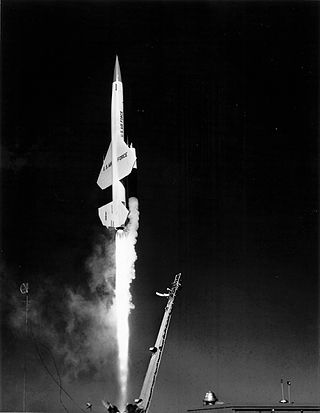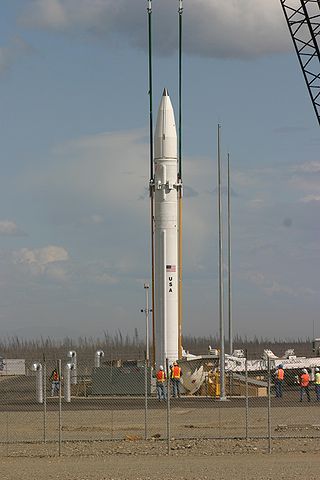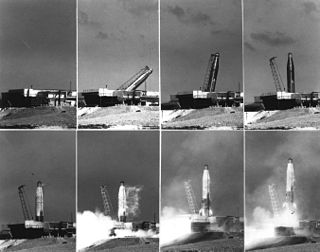
The Boeing CIM-10 Bomarc was a supersonic ramjet powered long-range surface-to-air missile (SAM) used during the Cold War for the air defense of North America. In addition to being the first operational long-range SAM and the first operational pulse doppler aviation radar, it was the only SAM deployed by the United States Air Force.

Vandenberg Space Force Base, previously Vandenberg Air Force Base, is a United States Space Force Base in Santa Barbara County, California. Established in 1941, Vandenberg Space Force Base is a space launch base, launching spacecraft from the Western Range, and also performs missile testing. The United States Space Force's Space Launch Delta 30 serves as the host delta for the base. In addition to its military space launch mission, Vandenberg Space Force Base also hosts space launches for civil and commercial space entities, such as NASA and SpaceX.

Ground-Based Midcourse Defense (GMD) is the United States' anti-ballistic missile system for intercepting incoming warheads in space, during the midcourse phase of ballistic trajectory flight. It is a major component of the American missile defense strategy to counter ballistic missiles, including intercontinental ballistic missiles (ICBMs) carrying nuclear, chemical, biological or conventional warheads. The system is deployed in military bases in the states of Alaska and California; in 2018 comprising 44 interceptors and spanning 15 time zones with sensors on land, at sea, and in orbit. In 2019, a missile defense review requested that 20 additional ground-based interceptors be based in Alaska.

The Maui Space Surveillance Complex (MSSC) is a U.S. Space Force operating location for the 15th Space Surveillance Squadron and the Air Force Research Laboratory (AFRL) at Haleakala Observatory on Maui, Hawaii, with a twofold mission. First, it conducts the research and development mission on the Maui Space Surveillance System (MSSS) at the Maui Space Surveillance Complex (MSSC). Second, it oversees operation of the Maui High Performance Computing Center (MHPCC). AFRL's research and development mission on Maui was formally called Air Force Maui Optical Station (AMOS) and the Air Force Maui Optical and Supercomputing observatory; the use of the term AMOS has been widespread throughout the technical community for over thirty years and is still used today at many technical conferences. The main-belt asteroid 8721 AMOS is named after the project.

The AN/FPS-108 COBRA DANE is a PESA phased array radar installation operated by Raytheon for the United States Space Force at Eareckson Air Station on the island of Shemya, Aleutian Islands, Alaska. The system was built in 1976 and brought online in 1977 for the primary mission of gathering intelligence about Russia's ICBM program in support of verification of the SALT II arms limitation treaty. Its single face 29 m (95 ft) diameter phased array radar antenna 52.7373°N 174.0914°E faces the Kamchatka Peninsula and Russia's Kura Test Range. COBRA DANE operates in the 1215–1400 MHz band.

Space Launch Complex 6 at Vandenberg Space Force Base in California is a launch pad and support area. The site was originally developed starting in 1966, but no launches occurred until 1995, as it was repurposed sequentially for three programs that were subsequently cancelled. Initially to be used for Titan IIIM rockets and the Manned Orbiting Laboratory, these were cancelled before construction of SLC-6 was complete. The complex was later rebuilt to serve as the west coast launch site for the Space Shuttle, but went unused due to budget, safety and political considerations. The pad was subsequently used for four Athena rocket launches before being modified to support the Delta IV launch vehicle family, which used the pad for ten launches from 2006 until 2022. The last Delta IV launched in September 2022, and SpaceX leased SLC-6 in 2023 to convert it to launch Falcon 9 and Falcon Heavy starting in 2025.
The Space Tracking and Surveillance System was a pair of satellites developed by the United States Missile Defense Agency (MDA) to research the space-based detection and tracking of ballistic missiles. Data from STSS satellites could allow interceptors to engage incoming missiles earlier in flight than would be possible with other missile detection systems. The STSS program began in 2001, when the "SBIRS Low" program was transferred to MDA from the United States Air Force. In December 2002, SBIRS Low Research & Development was renamed Space Tracking and Surveillance System (STSS).

Launch Complex 576 is a group of rocket launch pads at Vandenberg Space Force Base. The pads were used from 1959 until 1971 to launch SM-65 Atlas missiles. The site was also known as Complex ABRES. Pads in Area 576 include 576A-1, 576A-2 and 576A-3, 576B-1, 576B-2 and 576B-3, 576-C, 576-D, 576-E, OSTF-1 and OSTF-2.

The 395th Tactical Missile Squadron is a United States Air Force unit. It has not been active under that name.
Vandenberg Space Force Base Launch Facility 02 (LF-02) is a former US Air Force Intercontinental ballistic missile launch facility on Vandenberg SFB, California, USA. It was a launch site for the land-based Minuteman and Peacekeeper missile series. In the 2000s the silo was remodeled into a launch site for an Interceptor for the Ground-Based Midcourse Defense System.
Vandenberg Space Force Base Launch Facility 04 (LC-04) is a former United States Air Force (USAF) Intercontinental ballistic missile (ICBM) launch facility on Vandenberg Space Force Base, California, USA. It is a launch site for the land-based LGM-30 Minuteman missile series.
Vandenberg Space Force Base Launch Facility 05 (LC-05) is a former US Air Force Intercontinental ballistic missile launch facility on Vandenberg SFB, California, USA. It was a launch site for the land-based Minuteman missile series.
Vandenberg Space Force Base Launch Facility 06 (LC-06) is a former US Air Force Intercontinental ballistic missile launch facility on Vandenberg SFB, California, USA. It was a launch site for the land-based LGM-30 Minuteman missile series.
Vandenberg Space Force Base Launch Facility 07 (LC-07) is a former US Air Force Intercontinental ballistic missile launch facility on Vandenberg SFB, California, USA. It was a launch site for the land-based Minuteman missile series.
Vandenberg Space Force Base Launch Facility 08 (LC-08) is a former US Air Force Intercontinental ballistic missile launch facility on Vandenberg SFB, California, USA. It was a launch site for the land-based Minuteman missile series.
Vandenberg Space Force Base Launch Facility 09 (LC-09) is a US Air Force Intercontinental ballistic missile launch facility on Vandenberg SFB, California, USA. It is a launch site for the land-based Minuteman missile series.
Vandenberg Space Force Base Launch Facility 10 (LC-10) is a US Air Force Intercontinental ballistic missile launch facility on Vandenberg SFB, California, USA. It is a launch site for the land-based LGM-30 Minuteman ICBMs.
Vandenberg Space Force Base Launch Facility 21 (LF-21) is a former US Air Force Intercontinental ballistic missile launch facility on Vandenberg SFB, California, USA. It was a launch site for the land-based Minuteman missile series. In the 2000s the silo was remodeled into a launch site for an Interceptor for the Ground-Based Midcourse Defense System.

100th Missile Defense Brigade, known as 100th MDB (GMD), is a multi-component United States Army National Guard brigade headquartered at Schriever Space Force Base, Colorado. It has component formations located in Fort Greely, Alaska, Vandenberg Space Force Base, California, and Fort Drum, New York manned by national guardsmen of the 49th Missile Defense Battalion, 100th MDB, Detachment 1, and 100th MDB, Detachment 2 in Alaska, California, and New York, respectively, on a round-the-clock 24/7/365 basis. 100th MDB (GMD) is part of the United States Army Space and Missile Defense Command.
Launch Complex 576A, also known as Area 576, is a group of rocket launch pads at Vandenberg Air Force Base. The pads at the complex were used from 1959 until 1971 to launch SM-65 Atlas missiles. The site was also known as Complex ABRES. Pads in Area 576A include 576-A-1,2,3









